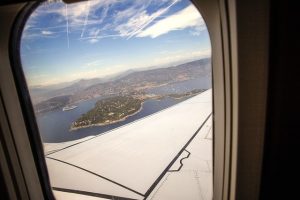 Airlines typically require passengers to open their window shades during takeoffs and landings. Once an airplane has reached cruising altitude — 31,000 to 38,000 feet — passengers can close them. At lower altitudes, though, passengers must keep their window shades open. Considering that window shades are used for visibility purposes, you might be wondering why they must be open during takeoffs and landings. Well, there’s a good reason why airlines require passengers to keep them open during takeoffs and landings.
Airlines typically require passengers to open their window shades during takeoffs and landings. Once an airplane has reached cruising altitude — 31,000 to 38,000 feet — passengers can close them. At lower altitudes, though, passengers must keep their window shades open. Considering that window shades are used for visibility purposes, you might be wondering why they must be open during takeoffs and landings. Well, there’s a good reason why airlines require passengers to keep them open during takeoffs and landings.
Eyesight Adjustment
With their window shades open, passengers’ eyes will adjust to the outside light. Time is of the essence during an emergency. The longer it takes passengers to exit the airplane during an emergency, the greater the risk of injuries and fatalities. Of course, it will take passengers longer to exit the airplane if their eyes haven’t yet adjusted to the outside light. If the airplane’s interior is dark while its exterior is bright and sunny, passengers may struggle to quickly exit the airplane during an emergency. Therefore, airlines require passengers to open their window shades during takeoffs and landings to allow for eyesight adjustment. It acclimates passengers’ eyes to the outside environment so that they can exit the airplane if an emergency occurs.
Spot Hazards
Another reason airlines require passengers to open their window shades during takeoffs and landings is to spot hazards. Pilots have a myriad of control systems to identify potential hazards. Nonetheless, it’s always better to have more “eyes” watching the airplane — as well as its surrounding environment — so that they can spot hazards. Of course, passengers won’t be able to see potential hazards if their window shades are closed. They may hear strange noises, but they won’t be able to see hazards involving the airplane’s wings or its surrounding environment. As a result, airlines require passengers to open their window shades during takeoffs and landings. If something goes wrong, passenger may spot it. In turn, the passenger can notify the nearest flight attendant so that the hazard doesn’t lead to injury.
Folding Tray Tables
The main rain airlines require passengers to open their window shades during takeoffs and landings is to encourage faster evacuation times if an emergency occurs. This same principle holds true for the tray tables. During takeoffs and landings, airlines will ask passengers to fold their tray tables in an upright position. With their tray tables folded up, passengers can evacuate the airplane more quickly in the event of an emergency.



